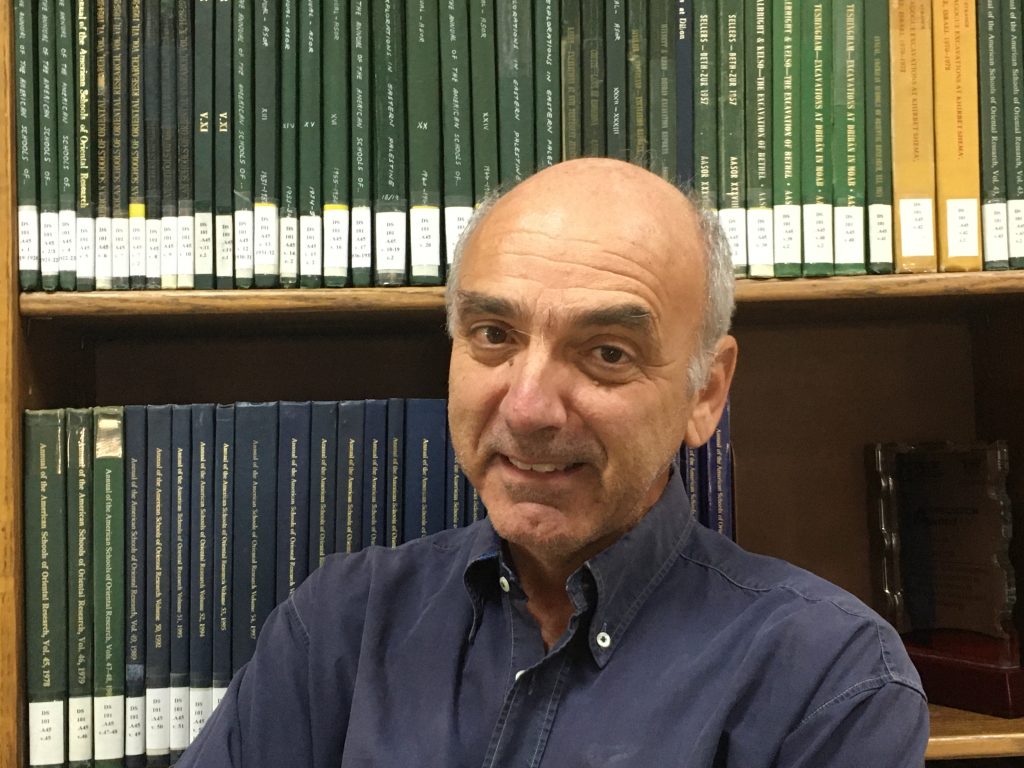Dr. Konstantinos D. Politis is an ACOR-CAORC Post-Doctoral Fellow in the fall of 2019. Dr. Politis is chairperson of the Hellenic Society for Near Eastern Studies, and he leads an ongoing excavation of Zoara, modern Safi in Jordan. During his ACOR fellowship, he plans to complete studies of the finds from Khirbet Qazone where he completed archaeological fieldwork in 2004.

Khirbet Qazone, located near the southeastern shore of the Dead Sea in Jordan, was discovered in 1996 and surveyed and excavated until 2004. Khirbet Qazone has been identified as Mahoza, mentioned in the 2nd century A.D. Babatha papyri that were discovered in the ‘Cave of Letters’ on the northwestern shore of the Dead Sea.

The excavation site is comprised of a large cemetery mostly dating from the 1st – 3rd centuries A.D. Burial remains at the site include pottery, jewelry, engraved tombstones, and textiles, as well as at least 53 identifiable Greco-Roman style tailored garments, many of which are complete. These garments are comparable to those found at Fayum in Egypt, Palmyra in Syria, and Masada in Israel/Palestine, but their exceptionally well- preserved condition makes them invaluable for study and exhibition. The manner in which the bodies were interned in a meter and a half deep arcosolia under-cut to the east and tightly sealed with adobe bricks, is similar to the characteristic burial method of Khirbet Qumran.
The last phase of the northern sector of the cemetery at Khirbet Qazone was early Christian as indicated by a different burial method, corpse orientation, and symbols on tombstones. This area is now associated with the discovery in 2015 of a nearby church.
______________________________________
Help ACOR Advance Knowledge
Donate to the ACOR Annual Fund today
Assist us in providing our programs and services to researchers worldwide
_______________________________________
Dr. Politis is an archaeologist educated in Greece, the United States, Belgium, and Britain. He obtained his doctoral degree in archaeology at the University of Ioannina in Greece in 2004. His early fieldwork was in Greece and Liechtenstein. From 1988 until 2011, he was based at the British Museum which sponsored his excavations in Jordan and Oman. He specializes in the early Byzantine and early Islamic periods.
His most important work was the discovery and subsequent excavation of the Sanctuary of Lot on the south-eastern shore of the Dead Sea, followed by the publication of a major report on that project with the British Museum (2012). He has also published Holy Footprints across the Jordan: A Journey to the Ancient and Religious Sites on the Eastern Side of the Jordan Rift Valley (2010), The World of the Nabataeans (2007), and many scholarly articles. He has also conducted research on ‘The Origins of the Sugar Industry’, and he presented public lectures at ACOR in 2016 and in 2018 on the sugar industry in Ghor es- Safi, including on recent work supported through USAID SCHEP and other supporters.
Dr. Politis completed two projects for the Syrian and Greek governments: coordinating the documentation of all the mosaics of Syria, and an exhibition on Hellenistic Syria in the Hama Museum. He is also working with the Jordanian and Greek governments to conserve and shelter the mosaics and buildings of the Monastery of St. Lot. He also played a key role in establishing the Museum at the Lowest Place on Earth below the site with the support of Department of Antiquities.


Hello Mr Politis. My name is Ella Morgan from London KY. I have read of your knowledge of some Jewish tombstones in the Dead Sea area. I am interested in viewing these and am asking for any source of information you have. I am working with Joseph Dumond who has documented about 100. we would like to compare to see if you have knowledge of ones we do not have. Thank you , Sincerely Ella Morgan grannyella44@gmail.com